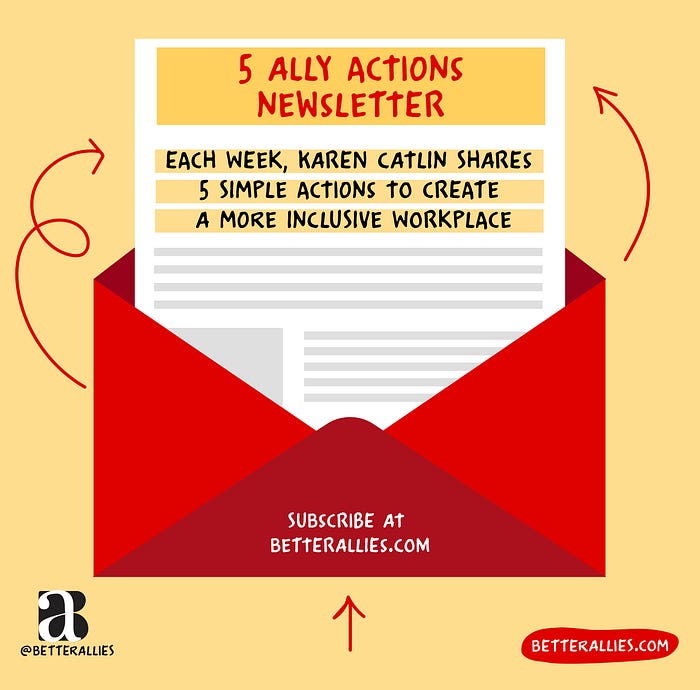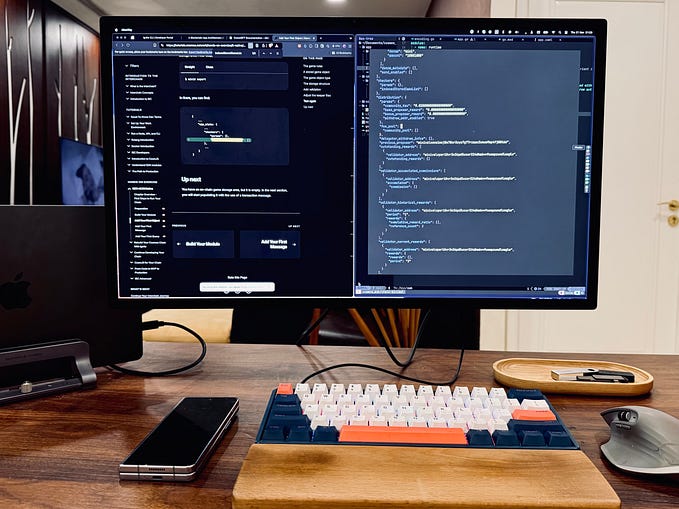Challenge Benevolent Sexism, and Other Actions for Allies
Each week, Karen Catlin shares five simple actions to create a more inclusive workplace and be a better ally.

1. Challenge benevolent sexism
In honor of Women’s History Month, a time to celebrate the achievements and contributions of women throughout history, let’s challenge benevolent sexism — a behavior that’s seemingly positive yet suggests women are weak and need protection.
Here are some examples:
- Expressing concern about a woman’s ability to handle a new role due to family obligations, like, “I don’t think she’s up for this promotion. She’s got her hands full with young children at home.”
- Avoiding burdening a woman with a task, such as saying, “I took care of that executive project update. Didn’t want to bother her.”
- Complimenting a woman’s appearance rather than her professional skills, such as saying, “Your presentation was great. Love the dress you wore.”
Unfortunately, benevolent sexism is widespread, and it significantly hampers women’s career progression.
To disrupt this bias when we witness it, we can say:
- “Let’s not make decisions on her behalf. Instead, let’s ask her if she’d like the promotion.”
- “She would have done a great job on the update. What made you think it would be a bother?
- “I agree her presentation was great. Let’s break down what she did effectively so we all can learn.”
Share this action on Bluesky, LinkedIn, Instagram, Threads, or YouTube.
2. Leverage the Three P’s
As you may know, one of President Trump’s Executive Orders directs federal executive departments and agencies to enforce civil rights laws to combat DEIA preferences, mandates, policies, programs, and activities in the private sector. There’s a similar order for federal agencies. While a Maryland court recently issued a preliminary injunction on both orders, effectively pausing aspects of them, they are still a concern for many organizations.
The Three Ps framework, developed by Kenji Yoshino, David Glasgow, and Christina Joseph of the Meltzer Center for Diversity, Inclusion, and Belonging at NYU School of Law, is a crucial tool in identifying DEI communications and offerings that may be legally risky. It advises against conferring a Preference (treating some groups differently from other groups) to a Protected group (e.g., based on race, color, national origin, religion, sexual orientation, or gender identity) that relates to a Palpable benefit.
Consider the legal implications of certain DEI initiatives that hit the Three Ps. For instance, a quota of 45% of all new hires being women, or a targeted program such as a fellowship or scholarship exclusively for Black people could pose legal risks.
By contrast, there are DEI programs or communications that don’t hit all of the Three Ps and, therefore, shouldn’t be considered risky. For example, conducting outreach at a women’s conference or historically Black colleges and universities (HBCUs) to strive for a diverse applicant pool. Holding patent training for women engineers to encourage them to identify patentable ideas while welcoming all employees to attend. Using structured interviewing techniques to reduce bias. Offering allyship lunch-and-learns to create a culture of inclusion.
How might you leverage the Three Ps to not only reduce risk but also gain support for or justify your DEI initiatives?
3. Don’t neglect DEI work
Here’s one more suggestion from Kenji Yoshino and David Glasgow, which I heard on a recent LinkedIn Live session hosted by author and organizational consultant Lily Zheng.
Yoshino underscored the importance of maintaining DEI programs, explaining that they’re the first line of legal defense for organizations to defend themselves from discrimination lawsuits filed by women, people of color, LGBTQ+ individuals, and members of other protected classes.
He also warned that if an organization cancels its DEI efforts, they’re “in for a world of pain.”
This guidance serves as a stark reminder of the potential legal consequences of neglecting DEI work.
4. Hold an accessibility hackathon
This suggestion comes to you from my daughter, Emma Chavez. She’s CTO at Formally, a legal tech startup in San Francisco, where she brings an inclusive mindset to everything she undertakes.
Even though her team is small, accessibility is a focus. Their goal is to add alt text (emphasizing good alt text!) to the images on their website, social media posts, and blogs to describe them for people using screen readers. They also look for ways to integrate adding and checking for alt text in their code review and content publishing processes.
Emma added, “I know my team’s codebase and social media posts aren’t perfect, but this is one of the things that’s much easier to do from the start rather than having to audit your codebase and posts down the line.”
She also led an accessibility-focused day-long hackathon to learn more about accessibility, hear from their partners about accessibility challenges their clients might encounter, and work on creative solutions together.
Let’s all consider our work and how it could benefit from an accessibility-focused review day to identify and fix issues.
5. Community Spotlight: Insist they use the mic
This week’s spotlight on an ally action from the Better Allies community is from Gill Le Fevre, who wrote,
“I was co-hosting recently, and the other host told me they didn’t need a mic. Educated by this newsletter, I replied, ‘Yes, you do. It’s inclusive. There could be people in the audience with non-visible hearing needs.’ And they took my point. (And, as it turns out, there actually was!!)”
As I’ve shared before, using a mic helps attendees with hearing loss and those using assistive listening devices. It also benefits sign language interpreters and close-captioners, as they rely on clear audio to accurately transcribe the proceedings.
Thank you, Gill, for insisting they use the mic.
If you’ve taken a step towards being a better ally, please reply to this email and tell me about it. And mention if I can quote you by name or credit you anonymously in an upcoming newsletter.
That’s all for this week. I wish you strength and safety as we all move forward.
Karen Catlin (she/her), Author of the Better Allies® book series
pronounced KAIR-en KAT-lin, click to hear my name
Copyright © 2025 Karen Catlin. All rights reserved.
Being an ally is a journey. Want to join us?
- Follow @BetterAllies on Bluesky, Instagram, Medium, Threads, or YouTube. Or follow Karen Catlin on LinkedIn
- This content originally appeared in our newsletter. Subscribe to “5 Ally Actions” to get it delivered to your inbox every Friday
- Read the Better Allies books
- Form a Better Allies book club
- Get your Better Allies gear
- Tell someone about these resources
Together, we can — and will — make a difference with the Better Allies® approach.








